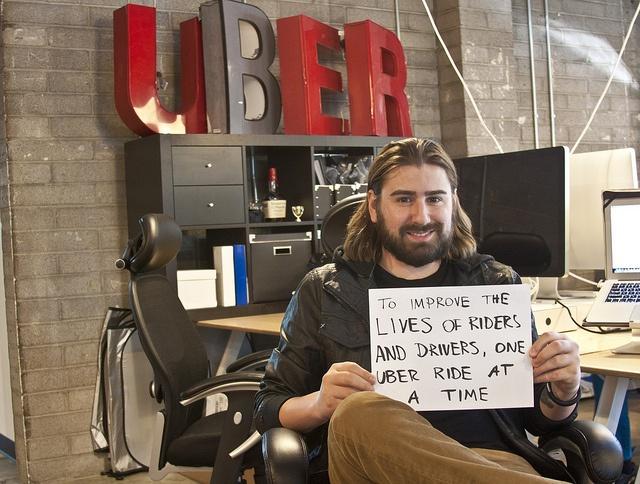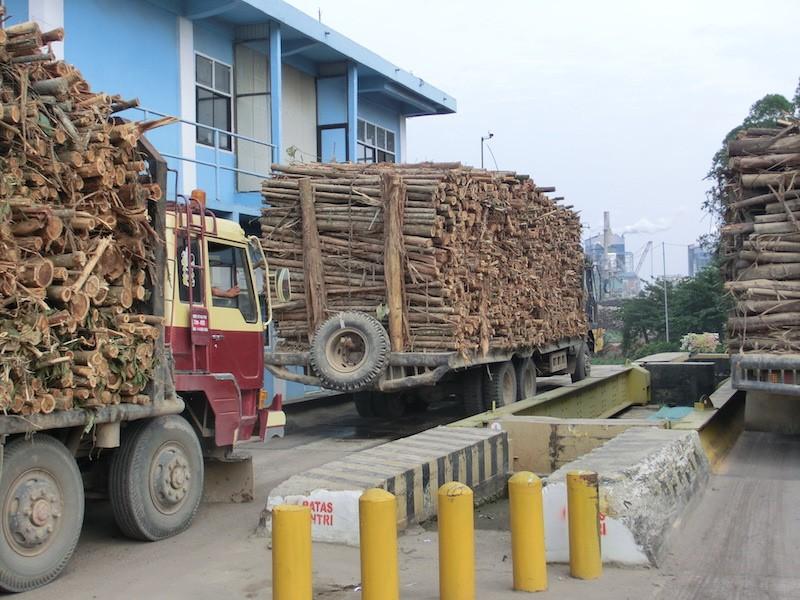3p Weekend: 10 'Role Models' Walk the Runway at NYFW


With a busy week behind you and the weekend within reach, there’s no shame in taking things a bit easy on Friday afternoon. With this in mind, every Friday TriplePundit will give you a fun, easy read on a topic you care about. So, take a break from those endless email threads, and spend five minutes catching up on the latest trends in sustainability and business
Carrie Hammer graduated from the University of California, Los Angeles with a degree in economics, and began her career as an advertising sales executive. At her new job, Hammer set out to dress for success, but she felt stifled with the limited options of fashionable professional clothing for women.
After years working in corporate advertising, Hammer left in 2012 to start her own company, Carrie Hammer, a custom dress line for professional businesswomen. The premise behind her brand is that "clothing should be made to fit the woman, and not the other way around."
Hammer made headlines with her debut runway show this month, ‘Role Models Not Runway Models,’ which included powerhouse women from CEOs and entrepreneurs, to the first model with Down syndrome to walk the runway at New York Fashion Week.
This week we tip our hats to Hammer for her bold choice -- and to her beautiful 'role models' who turned heads on the runway and kept us inspired.
[gallery ids="210697,210698,210699,210700,210701,210702,210703,210704,210705,210706"]
Image credits: Brian Ach/Getty Images (used with permission)
Mary Mazzoni is the Senior Editor of TriplePundit. You can follow her on Twitter @mary_mazzoni.
Walmart to Increase Wages to $9 an Hour for 500,000 Workers


Walmart announced earnings on Thursday. Between fourth-quarter figures for earnings-per-share, comp sales and revenue was a stunning announcement: The retail giant plans to increase wages for 40 percent of its workforce, some 500,000 employees.
The move will bring wages for hourly associates up to $9 per hour by April, $1.75 above today's federal minimum wage, the company said. The following year, by Feb. 1, 2016, current associates will earn at least $10 per hour.
This is huge news for the company, the largest private employer in America, which has faced mounting pressure from employees and advocacy groups to increase wages. It was the target of a slew of protests last year that culminated in demonstrations at 1,600 Walmart stores on Black Friday. The company has also taken flak for holding canned food drives for its own employees. And a 2014 study estimated that Walmart workers cost taxpayers an estimated $6.2 billion in public assistance like food stamps, Medicaid and subsidized housing.
So, is the big-box giant long bemoaned as the poster child for unlivable wages finally turning over a new leaf?
"Strengthening investments in our people"
"We're strengthening investments in our people to engage and inspire them to deliver superior customer experiences," Walmart CEO Doug McMillon said in a statement. "We will earn the trust of all Walmart stakeholders by operating great retail businesses, ensuring world-class compliance, and doing good in the world through social and environmental programs in our communities."Walmart has seen traffic slow recently: Q4 represented the first rise in shopper traffic in more than two years. McMillon's comments indicate that the evolving demands of customers -- made painfully obvious by dips in foot-traffic -- may be part of the reason for the change of heart on wages. Notice the use of the word "stakeholders" -- a shift from the shareholder value mantra to recognizing the needs of all stakeholders (including employees) has been a resounding chorus of advocacy groups.
McMillon reiterated this apparent shift in mindset in a letter to employees about the announcement. It's worth a read in full, but top quotes include: "Our actions must match our beliefs." And, "Our business is pretty simple when we boil it all down; sometimes we make it too complicated."
For its part, Walmart has made a noticeable shift toward more sustainable business practices in recent years. The retail giant is a leading private purchaser of renewable energy and has dramatically cut its energy footprint. It has rolled out policies on chemical ingredients and sustainable food and made headlines for bolstering women-owned businesses and hunger relief organizations.
As is the case in many other industries, labor is generally the last shoe to drop when it comes to getting serious about sustainability. In the grand scheme of things, it's not that hard to head into the board room and pitch an energy efficiency program that will save the company money in quick order. An initiative that will help a company's lowest earners at the expense of the bottom line can be a much tougher sell.
Are we trending toward higher wages?
Opponents of a minimum wage hike say higher wages would tank company revenues and be disastrous to the economy. Shareholders seem to share this concern: Walmart stock took a noticeable dip of nearly 3 percent after the announcement on Thursday. (Although it's too early to tell whether or not shareholders will warm up to the idea.)So, just how hard will this wage hike hit Walmart?
The company posted a Q4 revenue of $131.6 billion, outpacing analysts' expectations and bringing its fiscal year revenue to $486 billion. It also bested forecasts by earning $1.61 per share. (Believe it or not, that's actually nothing for the retail giant to write home about: McMillon said the company was "not satisfied" with its performance.)
In contrast, this broad-sweeping wage initiative -- which has the potential to pull a half-million struggling workers out of poverty -- will cost the company $1 billion during this fiscal year, McMillon said. A billion dollars isn't exactly chump change, but it's dwarfed by the company's annual earnings. And, although it's more difficult to quantify the benefits of higher employee satisfaction, retention and engagement, it's not hard to argue that Walmart will see a return on its investment. Just ask McMillon:
"When we take a step back, it’s clear to me that one of our highest priorities must be to invest more in our people this year," he wrote in his letter to employees.Walmart also has the benefit of comparing its own post-wage-hike numbers with those of other leading retailers, like Gap and Ikea, that recently boosted their minimum hourly wages. Industry leaders like Costco -- a direct competitor with Sam's Club -- and Ben & Jerry's do workers one better: The average hourly rate at Costco is more than $20, and an entry-level Ben & Jerry’s worker earns $15.97 per hour, a figure based on the living wage in Vermont. Meanwhile, state and local governments have also shifted to higher minimum wages -- most notably Seattle, which will phase-in a $15 minimum wage starting in April.
Having a mega-retailer like Walmart jump on board with higher wages is huge for advocates seeking a living wage for all. Whether other market leaders will follow suit is yet to be seen, but we'll have our eyes open.
Interested in the living wage conversation? Keep an eye out for a 3p exclusive series -- "In Pursuit of Fair Pay: TriplePundit Explores the Minimum Wage Debate" -- at the end of this month.
Images: 1) Matt Hamilton via Flickr user Neon Tommy 2) Flickr/SocialJusticeSeeker812 3) Google Finance
Is the 'Uberization' of the Economy Sustainable?


Although it’s probably too early to offer candidates for Oxford Dictionaries' Word of the Year, I’d like to suggest uberization as the word for 2015.
According to Oxford Dictionaries the Word of the Year should “reflect the ethos, mood or preoccupations of that particular year and to have lasting potential as a word of cultural significance.”
Now, my argument for the Oxford’s selection team is that in 2015 we see a shift from focusing solely on the phenomenon of Uber to a broader discussion about uberization, which could be described as utilizing the Uber business model in different sectors (from healthcare to real estate and food delivery).
I’m not sure if this is a winning argument, but with or without the recognition of Oxford Dictionaries this seems a good time to have a look at uberization and more specifically at the question that is of more interest to this space: Is the Uber innovation model others are so eager to adopt sustainable?
It’s very easy to see why the Uber model is attractive: meshing mobile technology, dynamic pricing and dynamic supply to create a disruptive and delightful user experience. After all, what could be wrong about creating a more dynamic ride-hailing service, taking the friction out of the process? And doesn’t it go hand-in-hand with Saul Kaplan’s definition of innovation -- “a better way to deliver value”? It certainly looks like it does!
Still, it ain’t all perfect in Uberland.
The problem is mainly with one of the main pillars of the Uber model -- “undercutting the higher fixed and marginal costs of conventional businesses.” Now, in fairness, this element could be found in other sharing economy services as well, including Airbnb, Lyft, RelayRides and others. The reason we talk about Uberization and not Airbnb-ization (though others do) is that Uber seems to be the most successful venture in this space, at least in terms of valuation ($40 billion) and fundraising (close to $5 billion). And frankly the company has developed and improved this element into perfection.
When talking about it in economic terms, such as undercutting costs or efficiently allocating human beings and their possessions, the Uber model doesn’t sound that bad. One might get suspicious, though, when thinking about the resemblance to Frederick Taylor’s principles of scientific management, where Taylor argues for breaking the work for tasks (he claims the concept of task is “perhaps the most prominent single element in modern scientific management”) and finding the most cost-effective way to complete them.
I’m mentioning Taylor for two reasons: First, it’s interesting to see how Taylor’s principles -- that were for so many years associated with management of large organizations -- are now echoed in the principles of an advanced innovation model. Second, Taylor was interested in finding the best way to maximize the prosperity of both the employer and the employee.
Now, uberism is not Taylorism even though it aims to create hyper-efficient marketplaces and claims to improve drivers’ financial security and quality of life. The difference is that Taylorism was all about creating better control and predictability and reducing uncertainties for both the employer and the employee, and the Uber model doesn’t seem to do it -- at least not for the employee. Maybe it is because Uber drivers are not employees but independent contractors who ”don't enjoy the security and benefits of traditional jobs.”
As former Secretary of Labor Robert Reich puts it: “This on-demand economy means a work life that is unpredictable, doesn’t pay very well and is terribly insecure.” This is, of course, just one opinion. And we should not forget that the Uber model also provides greater flexibility and apparently an opportunity to make more money per hour of work.
Still, when I go back to Saul Kaplan’s definition of innovation (“a better way to deliver value”), or other definitions of innovations like that of Autodesk’s Carl Bass (a “process by which we change the world, making things better”), I am not sure whether the Uber model really meets these definitions, especially when it comes to service providers: Is it really benefiting them? Is it really making their lives any better?
And let’s not forget the bigger picture: Do we really want to see sector after sector become more uberized, resulting in an on-demand culture that dominates the (gig) economy?
It would probably be great for the consumer, but would it be any different from unsustainable economic activities like fast fashion or fast food? And we could also assume that many consumers will also be on-demand service providers, so would it actually be that great for them? I doubt it.
So, you might wonder if I think that it would be better to ditch the Uber model and go back to hailing taxis. The answer is no. I don’t like hailing taxis and would like to have better and more delightful experiences. At the same time, I believe that sustainability is not just about addressing environmental challenges, but also about addressing social ones.
It means that we need to find an innovation model that is committed to improve not the prosperity of a small number of shareholders, but the prosperity of a large number of stakeholders, including service providers.
We can’t and shouldn’t try to stop progress, but I believe we could find a better innovation model than the Uber model -- one that has a better balance between fairness and flexibility, opportunities and equality. We need a model that, at the end of the day, will create not just disruptive and delightful experiences, but also an eco-system that delivers better value to all of its participants.
Image credit: Yscouts, Flickr Creative Commons
Raz Godelnik is an Assistant Professor of Strategic Design and Management in the School of Design Strategies at Parsons The New School for Design. You can follow him on twitter @ecolibris
Crude Oil Spills Prompt New Questions About Safety


The derailments of two cargo trains earlier this week are prompting questions about safety precautions for North America's rail systems. They're also spurring debate about whether crude oil shipments have a place on the rails that pass through America's small towns.
More than 60 people were evacuated from their homes in the small town of Montgomery, West Virginia, after a CSX train carrying crude to a refinery derailed and caught fire. One house was destroyed, and the town's drinking water was contaminated by an oil spill.
Less than 48 hours earlier, another oil train traveling through eastern Canada burst into flames when it derailed in a forested area near Timmins, Ontario. The fire was still burning late this week. Rail authorities say the train and the tracks had both been inspected prior to the train departing the depot.
The West Virginia accident occurred during adverse weather that had prompted weather and driving advisories. It is unclear whether the Ontario accident was related to weather issues, although most of the eastern portion of Canada has been experiencing increased snow and ice, prompting travel and weather warnings.
With the increase in crude oil shipments across the U.S. and Canada, some environmental groups are expressing concern about the safety of residents along rail routes. They noted that many areas are unprepared for an accident resulting in oil spills to drinking water or uncontrolled fire, such as the incident that occurred this week in West Virginia. Forest Ethics pointed out that an estimated 25 million Americans live along rail routes that carry crude shipments and that, since 2008, rail shipments have increased by 4,000 percent. Its oil blast zone website provides a map of the crude oil shipments that cross North America, which extend across most states and provinces.
It is unclear why commercial train traffic that carries flammable cargo is not restricted during adverse weather conditions, such as those West Virginia and Ontario have recently experienced. In Idaho and eastern British Columbia, where adverse conditions commonly restrict travel, train transports are rarely restricted during difficult weather. With many rural areas in the two countries depending on volunteer resources for firefighting or search-and-rescue, some areas have begun to ask if they are adequately prepared to respond to potential derailments. In May 2014, the Department of Transportation stepped up regulations requiring rail operators to advise State Emergency Response Commissions when more than a million gallons will be shipped through their states.
The International Association of Fire Chiefs responded to the announcement by noting that while communications about intended shipments are always helpful for local communities, "such notifications would do little to help local responders adequately prepare for a rail incident."
Although both the U.S. and Canada have promised increased safety regulations to prevent accidents such as last the 2013 devastating rail disaster in Lac Mégantic, Quebec, it would appear that a lot more thought needs to go into safety precautions for transporting North America's most controversial commercial product.
Image credit: Roy Luck
Modernist Icon GM Technical Center Undergoing a Gradual Green Upgrade


When it opened in 1956, General Motors Technical Center was lauded as a place where “today meets tomorrow.” The 710 acre complex in Warren is home to 61 buildings and a 22,000 acre lake, cost about $US100 million to build and symbolized America’s and Detroit’s industrial might, innovation and optimism. When it opened, over 5,000 leaders in engineering and science came for the dedication ceremony and over 180,000 people visited the Center over the next two days. Designed by Eero Saarinen, whose work also included the Gateway Arch in St. Louis and the TWA Flight Center at JFK International Airport in New York, designed what is now recognized as one of the largest modernist architectural masterpieces in the U.S. As noted during a talk Triple Pundit attended at Modernism Week in Palm Springs, the Technical Center is a leading example of mid-century architecture in Michigan, where much of this shift in design has much of its origins.
For the most part the Technical Center looks the way it did almost 60 years later. Some of the original interiors were lost, but for the most part this “Versailles of Industry” is still intact and screams more of a Mad Men than Chevy Volt vibe. The Center still is the locus of GM’s research and development and is the work address for 19,000 employees. While the function of the complex has not changed, the complex is slowly undergoing a green upgrade reflective of what more 21st century employees are seeking in their work environment.
The first things visitors will notice (once the especially bitter Michigan winter subsides) are the bicycles that employees ride to commute between buildings. Launched last year, the on-campus bicycle sharing program, operated by Zagster, offers employees the opportunity to score a little more exercise while overall worker productivity has improved thanks to reduced waits from avoiding a long walk or shuttle ride.
Such a sprawling network of buildings requires massive amounts of energy, especially when considering all the data the company stores online. To that end, GM revamped the data center within the complex, leading to a LEED gold certification and the elimination of a larger heating and cooling system—or as a GM representative has been quoted, its redesign nixed the equivalent of a football field sized room of batteries. Energy efficiency has also scored a small boost from a 49 kilowatt solar array within the center.
While next generation technology is coded and hammered out inside, 30 acres within the complex have recently been certified as wildlife habitat on the outside. Duck boxes made out of repurposed Chevy Volt battery cases are scattered around the complex, and additional man-made lakes regularly attract migratory birds. Trees outline the perimeter of the center while more “no-mow” spaces have been designated to encourage the growth of native plants.
As GM expands its zero-waste program worldwide, this massive complex continues to reduce waste and encourage recycling: at last count the total waste generated within the Technical Center has decreased 35 percent.
GM, as has the American automobile industry at large, has taken its lumps the past 30 years. But the Technical Center has been a steady constant as the company retooled, restructured and adjusted to the changing demands from consumers. It may no longer be the world’s largest car company, but GM continues to attract leading scientists and engineers, and still reflects the vision of Charles Kettering, who was head of research at GM from 1920 to 1947. When the first plans were drawn up for the Technical Center during the 1940s, Kettering made it clear he wanted solid buildings with streamlined design that would encourage innovative thinking. “I don’t want fancy,” was a mantra he kept repeating during the Center’s conception. Hardly fancy, the straight lines and graceful curves that are a rule the complex have been largely untouched—only now they are undergoing a sustainable upgrade necessary at a time of diminishing resources and increased demands for efficiency.
Based in California, Leon Kaye is a business writer and strategic communications specialist. He has also been featured in The Guardian, Clean Technica, Sustainable Brands, Earth911, Inhabitat, Architect Magazine and Wired.com. When he has time, he shares his thoughts on his own site, GreenGoPost.com. Follow him on Twitter and Instagram.
Image credits: Michigan Modern
Rainforest Alliance Reviews Paper Giant's Forest Conservation Efforts


Feb. 5 marked the two-year anniversary of paper giant Asia Pulp and Paper's commitment to halt further felling of the natural rainforest in all of its 38 supplier concessions in Indonesia. This commitment was a key part of the company's Forest Conservation Policy (FCP) announced back in February 2013.
While FCP was cautiously welcomed by various environmental groups, many remained skeptical as to whether Asia Pulp and Paper (APP) would hold the line on the promises made.
Since the 2013 announcement, central to APP's efforts has been the retention of a number of third-party organizations with expertise in evaluating both the High Carbon Stock (HCS) and High Conservation Value (HCV) of forests within its supplier concessions. And later on, the company expanded on these efforts with the formation of a peat expert team to evaluate how best to protect this fragile ecosystem found extensively throughout supplier forests. APP stated from the outset that recommendations made by these expert teams would be adopted by the company as part of ongoing and comprehensive forest management plans.
Since work on FCP began, the pulp and paper giant committed to an unprecedented level of transparency as well -- perhaps most significantly demonstrated by its invitation to have Rainforest Alliance undertake an independent evaluation of their progress. This month, Rainforest Alliance published its evaluation of the first 18 months of FCP (to August 2014). Here are the key findings.
Third-party evaluation
The good news: Rainforest Alliance found that, "APP has met its commitments to halt the cutting of natural forest for the purposes of establishing new plantation areas, stop the building of new canals in peat-lands by its suppliers and stop all transport of mixed tropical hardwood for its own pulp supply by August 31, 2013." The report also states that APP's journey to implement its ambitious commitments has required a tremendous amount of work, while confirming that building blocks are in place.
In broad terms, APP has delivered on some key, and important, actions. However, with such a major undertaking, Rainforest Alliance found that the company's overall progress to meet commitments varies, concluding that overall progress made is "moderate." The 83-page report dives down into the minutiae, and it is in the details where great complexity is revealed and where it is evident APP still has much work to do.
Here's an example: Although APP and its suppliers are no longer clearing natural forest -- and APP is no longer receiving mixed tropical hardwoods at its mills -- the report finds that areas of forest in designated HCS and HCV areas are still subjected to degradation by third parties. Activities such as illegal logging, small scale slash-and-burn by local communities, and, in a few cases, industrial-scale mechanical clearance for palm oil or mining purposes has taken place. As a result, Rainforest Alliance concludes there remains overall inadequate protection of HCS and HCV areas.
To be fair, though -- and this is where the challenges and complexities are revealed -- APP has previously said it cannot be successful by going it alone. A year ago, before this report, APP identified problems with overlapping licenses in concession areas leading to conflicting land use with other actors. At the time, the company called for wider stakeholder cooperation with businesses, government and civil society to resolve these issues. Rainforest Alliance concedes in its report that it acknowledges "huge challenges facing supplier companies in addressing unauthorized clearance of natural forest and protecting HCS and HCV areas," going on to say in the report: "The challenges include the unwillingness or inability of local authorities including governments to enforce legal requirements."
More work to be done
Still, the report does place some time pressure on APP to conclude some of the work undertaken. The report identifies that APP's suppliers are waiting for the company to issue their Integrated Sustainable Forest Management Plans (ISFMPs) "before taking significant steps to implement more definitive measures to protect HCV and HCS areas." ISFMP's in turn are dependent upon the completion of HCS and HCV assessments, and the delivery of these was delayed, and not fully completed, as of August 2014. At the time of the report, one pilot ISFMP project was underway.
The management of peat-lands is also planned to be integrated into the ISFMPs, and Rainforest Alliance finds only limited progress has been made by the peat expert team. As such, Rainforest Alliance states, "APP faces a significant timing or sequence challenge if it is to protect HCVs or HCS."
Another important area of review was the resolution of social conflicts. Rainforest Alliance says that APP has mapped social conflicts and established processes to begin resolving these conflicts. These number in the several-hundreds, with just one pilot social conflict resolution process being completed and with memorandums of understanding or action plans in place for 10 percent of the remaining. Rainforest Alliance says APP has made moderate progress in this area.
The bottom line
It would be easy to conclude that APP has failed to meet or exceed expectations, but at the same time, given the magnitude of APP's undertaking, it would be unrealistic to expect a perfect score just two years into reforming operations. A full reading of the report shows that while Rainforest Alliance identifies much more work must be done, the authenticity of APP's efforts is not called into question.
APP's managing director of sustainability, Aida Greenbury, welcomed Rainforest Alliance's evaluation, stating: "We are pleased that the Rainforest Alliance has recognized the progress we are making." But she added: "We must have the courage to continually improve as we learn lessons from implementation."
Greenpeace's reaction to the report commends it as being a fair and balanced assessment of, "just how far APP has come in delivering its policies to protect natural forests, peat lands and other high conservation values," though recognizes the important challenges APP still needs to tackle.
World Wildlife Fund, in contrast, reserves little praise for APP, stating that "not much has changed on the ground -- forests continue to disappear, peat soils continue to be drained and social conflicts remain unresolved." WWF appears to have remained APP's strongest critic since FCP was announced in 2013.
Despite these differing perspectives, the report is nonetheless a moment of truth for APP, and an opportunity for the company to build on its efforts to address the shortfalls identified. This becomes even more important because, as Mongabay.com's reaction to the evaluation highlights, there are concerns from organizations such as Woods and Waysides International. Woods & Waysides, a nonprofit based in New Jersey, is concerned that this report says nothing about how well APP will be able to meet the group's fiber supply on a sustainable basis as the company prepares to open the new OKI pulp mill in South Sumatra. Rainforest Alliance will address that in a future report, but in the meantime, APP should expect the scrutiny to intensify.
Photo credit: By Author
Follow me on Twitter @PhilCovBlog
Accused of Condoning Rape, Brazilian Beer Company Drops Carnaval Ad Campaign


Carnaval is wrapping up in Brazil, which has meant several days of costumes, parades, fantastic live music and a fair share of debauchery until the wee hours of the morning. The type of partying varies depending on what city or region you happen to be visiting, but there is no shortage of revelry, food and drink. And speaking of drink: One of Brazil’s most popular beer brands, Skol, found itself and its company, Ambev, in controversy after a poorly thought-out advertising campaign.
In São Paulo, Skol ads went up last week proclaiming "Esqueci o ‘não’ em casa," which literally means, “I forgot the ‘no’ at home.”
Considering the social ills any country has, including substance abuse and domestic violence — which can get magnified during a time like Carnaval — it should not have surprised the marketing department at Skol that more than a few people found the campaign offensive. Ambev, with sales of over US$14 billion annually and owned by the beverage giant Anhauser-Busch InBev, had to lurch into damage control.
The backlash against the Skol campaign was largely due to Pri Ferrari, who herself is an illustrator in the advertising industry. Upon seeing one of the ads at a bus shelter in São Paulo, Ferrari and a friend, journalist Mila Alves, altered the poster with electrical tape and amended the message so it read "Esqueci o 'não' em casa. E trouxe o 'nunca" ("I forgot the ‘no’ at home and brought the ‘never.’") Other women began to show their indignation, and the result was a social media nightmare for Skol and Ambev. Ferrari’s post on Facebook scored several thousand “likes,” and the hashtag #SkolNunca ("Skol never") then began to spread quickly on Twitter.
“A man will never be made to feel what we feel.” – Pri Ferrari, São Paulo, Brazil, when asked about her reaction to the Skol advertising campaign.
Realizing the company was dismissing the age-old lesson that “no means no,” and its cute slogan could appear to condone rape, Ambev pulled the ads and replaced them with new messages that carried a theme of respecting others. The company also issued a halfhearted formal apology, saying the original campaign was launched with the premise of just “enjoying the good times,” but realized that the slogan in question could result in a “dubious misunderstanding.”
Pallid apology aside, Ambev at least realized how offensive its ad campaign could be to, well, about half of Brazil’s population. The stunt also cheapened a Brazilian tradition that dates back to the 19th century and is full of cultural traditions and pageantry -- not just about excessive drinking and celebrating brands that try to capitalize, in this case quite carelessly, on the fun.
Image credits: Pri Ferrari/Facebook
Based in California, Leon Kaye is a business writer and strategic communications specialist. He has also been featured in The Guardian, Clean Technica, Sustainable Brands, Earth911, Inhabitat, Architect Magazine and Wired.com. When he has time, he shares his thoughts on his own site, GreenGoPost.com. Follow him on Twitter and Instagram.
Galapagos: Post Office Bay


Fun post for Friday: An interesting human behavior story from the Galapagos. Post Office Bay, on the Island of Floreana, has been serving as an improvised message board for travelers since the 19th century. Ships would periodically stop by and leave messages in the hopes that another ship might pick them up and take them to their intended destination in distant lands.
Today, it's tourists who stop by to collect postcards for delivery in their home towns across the globe. You might say it's the world's only crowdsourced post office that specializes in hand delivery. It's also an amusing throwback to an era when technology was a far less dominant force in people's lives.
Ed Note: Accommodations, travel and guidance in the Galapagos were courtesy of EcoVentura, which runs 7-night cruising expeditions around the islands.
How Sprint Supports Net Neutrality


An open Internet is something that is important to me as a freelance journalist, and apparently it is important to one of the major telecommunications companies, too: While AT&T, Verizon and Comcast have made things difficult for supporters of net neutrality, Sprint is taking a different tack.
Sprint Chief Technology Officer Stephen Bye spoke to Reuters: “It's one of those topics that is highly charged, highly politicized, and we took a step back and said it works in the interest of our customers, our consumers and the industry. And we frankly found some of the arguments (of our competitors) to be less than compelling,” Bye said. “Our competitors are going to continue to invest so they are representing a situation that won't play out."
The Federal Communications Commission (FCC) proposes to more strictly regulate Internet service providers under Title II of the Communications Act and Section 706 of the Telecommunications Act of 1996. The proposal would reclassify broadband Internet access service as a telecommunications service under Title II. The new rules would apply to mobile broadband which accounts for 55 percent of Internet traffic. Certain practices would be banned, including blocking access to legal content, paid prioritization and throttling (impairing or degrading lawful Internet traffic on the basis of content, applications or services). The FCC is expected to vote on the proposed rules during a meeting on Feb. 26.
Sprint wrote a letter to the FCC last month that stated it would support the FCC’s proposal. “Sprint does not believe that a light touch application of Title II, including appropriate forbearance, would harm the continued investment in, and deployment of, mobile broadband services,” the letter said.
Net neutrality: The Internet's guiding principle
The idea of an open Internet where everyone is treated on a level playing field is known as net neutrality. Save the Internet calls net neutrality “the Internet’s guiding principle.” But it has been under attack for years.
Under former FCC Chairman Michael Powell and former FCC Chairman Kevin Martin, the FCC tried to reclassify broadband Internet service as an “information service.” That took away the FCC’s ability to prevent Internet service providers from discriminating or blocking online content.
Last May, FCC Chairman Tom Wheeler released a plan that basically did away with net neutrality. As Save the Internet described the plan, it “would have allowed companies like AT&T, Comcast and Verizon to discriminate online and create pay-to-play fast lanes.” There was a public outcry, and the plan was toast.
Image credit: Mike Mozart
Citigroup Launches $100 Billion Sustainability Drive


America's largest banking groups are increasingly incorporating environmental and social considerations into lending and investment practices. They are also bringing sustainability in-house, launching initiatives to make greater use of clean energy, enhance resource efficiency, and reduce waste and pollution.
On Feb. 18, Citigroup made a landmark commitment to finance sustainable development across its worldwide business footprint. Management announced the group would “lend, invest and facilitate a total of $100 billion within the next 10 years to finance activities that reduce climate change and create environmental solutions that benefit people and communities.”
Investing in projects that make cities less polluting and resource-intensive, and hence improve quality of life, are focal points of Citi's sustainability-driven business strategy. “As part of a commitment to helping cities thrive during this period of unprecedented urban transformation, Citi will seek to finance and support activities that enable communities to adapt to climate change impacts," Citi management stated in a press release. They went on to say that the company would "directly finance infrastructure improvements that increase access to clean water and manage waste, while also supporting green, affordable housing for clients, including in low- and moderate-income communities."
Financing sustainable growth
Employing over 300,000 people across a global network that spans some 140 countries, Citigroup's $1.8-plus trillion of assets makes it one of the largest banking and financial services groups in the world. With this latest announcement, Citi is renewing its commitment to finance sustainable development.
Back in 2007, Citigroup management announced a goal of facilitating $50 billion in sustainable development initiatives by 2016. The company reached that goal three years ahead of schedule, Citi highlighted.
In its new $100 billion commitment, Citi aims to facilitate financing of renewable energy and energy efficiency projects. Management says staff company-wide will work with clients “to identify opportunities to finance greenhouse gas (GHG) reductions and resource efficiency in other sectors, such as sustainable transportation.” Citi has demonstrated its deep commitment to not only take environmental consequences into account, but also find innovative ways to finance projects that lead to sustainable growth.
Commenting on its latest sustainability finance and investment drive, CEO Michael Corbat highlighted Citi's longstanding commitment to helping realize transformative, beneficial change:
"For more than 200 years, Citi's mission has been to enable progress by facilitating economic growth and financing transformative projects. The core mission hasn't changed, but the way we approach it has. Incorporating the principles of sustainability into everything we do improves our own operations, enhances our clients' work and contributes to a better world."
James Alexander, who heads up the C40 Cities Climate Leadership Group's Finance and Economic Development Initiative, zoomed in how Citi's commitment will strengthen C40's efforts to reduce carbon emissions and enhance resiliency to climate change in cities worldwide. The C40 Cities Climate Leadership Group is a network of the world's biggest cities working to become more sustainable.
"Reducing carbon emissions and becoming more climate resilient is a key priority and major challenge for the world's megacities and their business communities," Alexander said. “C40's ongoing partnership with Citi is helping global cities overcome their climate finance challenges. Today's announcement from Citi will add further opportunities to help cities achieve their climate targets, and allow businesses to become more sustainable."
Citi's in-house investments
Making investments that reduce carbon emissions and waste, enhance energy efficiency, and make use of renewable energy are part of Citi's five-year strategy of focusing on environmental and social risk management. Guiding its strategy, the company set new environmental footprint goals that it aims to meet by the end of the decade. With 2005 as a baseline reference, these include:
- Reducing its own GHG emissions by 35 percent
- Realizing 30 percent reductions in energy and water use
- Reducing waste by 60 percent
In the longer term, Citigroup will employ a "climate science-based methodology” as it aims to reduce its own GHG emissions by 80 percent by 2050. Zooming in on its investment portfolio, Citi aims to have 33 percent of its real estate portfolio LEED certified. In addition, the banking and financial services group will seek to obtain LEED Platinum certification for its new global headquarters at 388/390 Greenwich St. in lower Manhattan.
Citi met its previous five-year internal GHG and waste reduction goals two years early in 2013, management highlighted. In doing so, the company reduced GHG emissions by 25 percent and the amount of waste sent to landfills by 41 percent as compared to 2005. Furthermore, it's on track to meet its 2015 goals for water use reduction (a 20 percent decrease). Additionally, the properties in its real estate portfolio are 20 percent more energy efficient, and 15 percent achieve LEED certification.
Commenting on Citi's performance to date, Mindy Lubber, president of nonprofit sustainability group Ceres, said: "Climate change is expected to impact virtually every sector of the economy.
“The financial services industry has a big role to play in scaling up global clean energy investments, and we applaud Citi's leadership as the company continues to innovate and expand its efforts."
Ceres was among a group of external parties and stakeholders that provided input and feedback as Citi formulated its sustainability goals and business strategy.
*Image credits: Citigroup